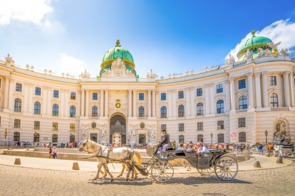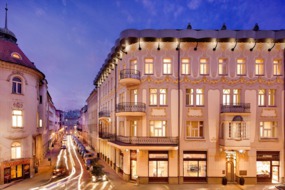
Duration
7 Nights
Journey Type
Cruise only (Please call for flight options)
Ports
6 Ports
22-23 March
Setting sail from Passau
The pretty Bavarian town of Passau, situated close to Germany's border with Austria, enjoys a unique setting at the confluence of three rivers: the Inn, the Ilz and the Danube. Passau grew rich on the back of the medieval salt trade, and went on to become the most important bishopric in the Holy Roman Empire; the narrow cobbled streets of the handsome old town, the Altstadt, haven't changed all that much in the centuries since.


Don't miss
If you’re here, it’s because you are going to be cruising on the Danube, but if you climb up above the town you can see the confluence of three rivers. It’s a great view.
24 March
Austria: Linz (Salzburg)

The city of Linz is included on river cruise itineraries due to its proximity to Salzburg, which is where you’ll most likely be headed. Salzburg’s Altstadt attracts millions of visitors every year with its fairytale skyline of domes and spires, and the city is renowned as both the birthplace of Mozart and the setting for ‘The Sound of Music’.
25 March
Austria: Dürnstein

One of the prettiest towns in Austria’s Wachau Valley, little Dürnstein charms visitors with its handsome 16th century architecture. Richard the Lionheart was once imprisoned in the castle that sits on the hillside above the town, and the region is also famous for its wine.
26 March
Austria: Vienna

Formerly the centre of the Habsburg Empire, Vienna is as grand a European capital as you can imagine, jam packed full of thrusting, bombastic buildings that stand as a reminder of Austria’s glorious imperial heyday.
27 March
Slovakia: Bratislava

Bratislava, Slovakia’s quaint little capital, straddles the Danube close to the border with Austria and Hungary. The compact old town is the best place to begin your exploration, before heading up to the hilltop castle for commanding views of the city and surrounding countryside.
28-29 March
Arriving in Budapest
Budapest is one of Eastern Europe's most appealing cities, a vibrant and welcoming capital that straddles the Danube. The history of Budapest has been somewhat turbulent - ransacked by the Mongols in 1241, occupied by the Ottoman Turks for over a century, and almost flattened by the Soviets in 1945 - but plenty of older buildings survive, including the imposing Parliament and iconic St Stephen's Basilica. Although a pedant might point out that Budapest has only really existed since 1873; up until then the city's two distinct halves, Buda and Pest, were separate towns.


Our tip
Hungarian cuisine is vastly underrated; don’t visit Budapest without trying goulash, the paprika-infused national dish.
Your home from home



What we love
This stunning ship, named after the 18th century Habsburg empress, has won countless plaudits since joining the Uniworld fleet in 2015. Individually decorated suites with cleverly designed French balconies open the rooms to the outside, and the outrageously over the top décor of the public spaces combines brilliantly with modern touches like the indoor heated pool at the back of the ship.
| Capacity | 150 Guests |
|---|---|
| Crew | 58 Staff |
| Style | Relaxed and informal during the day, giving way to an elegant evening atmosphere. |
| Inclusions |
|
Tailor-make your trip

Where to stay in Passau
Don’t hold your breath for anything amazing. That said, the Residenz Passau is quite nice.

Excursions from Passau
Burghausen is a short drive away and well worth a visit, not least for its magnificent castle.

Our favourite hotel in Budapest
We like the Hotel Palazzo Zichy on the Pest side of the river, which used to be the residence of Count Nándor Zichy.

A taste of Hungary
If you’re a wine lover, you really should visit the world’s oldest classified wine region, known for its sweet Tokaji aszú dessert wine.










